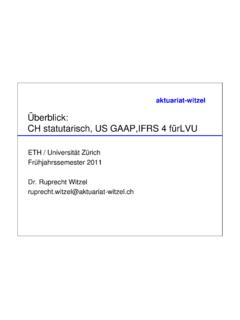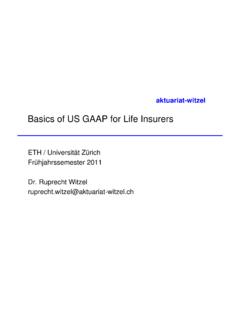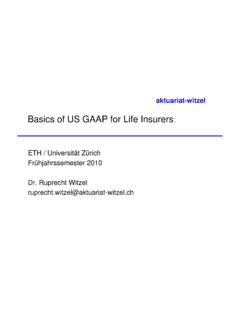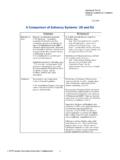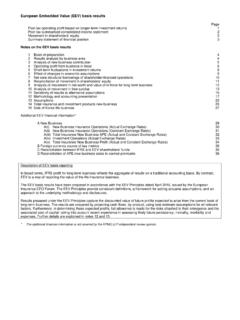Transcription of Basics of IFRS 4 for Life Insurers FS 11 - aktuariat-witzel
1 Basics of ifrs 4 for life InsurersETH / Universit tZ richFr hjahrssemester2011Dr. RuprechtWitzel; FS 11 Finanz. F hrungsinfo; Teil4; ifrs and P&L Acquisition Adequacy Accounting3Dr. RuprechtWitzel; FS 11 Finanz. F hrungsinfo; Teil4; ifrs 4 Content12. Discretionary Participation Feature13. Embedded Derivatives14. Investment Contracts without DPF (IAS 39)4Dr. RuprechtWitzel; FS 11 Finanz. F hrungsinfo; Teil4; ifrs 41. IntroductionThe implementation of the ifrs accounting standards for Insurers is planned in 2 phases: Phase I, in force since 2005, is documented in ifrs 4; it is only an interim solution with focus on disclosure In phase II, the planned final version of IFRSfor Insurers with focus on valuation, the "Fair Value Concept"should be introduced for all relevant Balance Sheet items The Fair Value Conceptimplies the valuation of all assets and liabilitiesof the Balance Sheet with market values, if existing, or with "market-near" values (market consistent valuation; marktnaheWerte )5Dr.
2 RuprechtWitzel; FS 11 Finanz. F hrungsinfo; Teil4; ifrs 41. Introduction The introduction of phase II is nowadays planned for 2011; but probably it is not possible to fulfill the timetable Coordinationwith solvency II(especially concerning the valuation of the liabilities) and US GAAPis striven for This coordination takes time An exposure draft of the new version of ifrs for Insurers was published in July 2010 and is now in discussion If this new version is accepted, it will imply a revolution for the accounting system of Insurers 6Dr. RuprechtWitzel; FS 11 Finanz. F hrungsinfo; Teil4; ifrs 41. Introduction In this paper the accounting system according to ifrs 4 for life Insurers is presented as it is valid in the year 2011 In a separate paper, the main ideas of the exposure draft of ifrs for life Insurers will be presented at the end of this lecture7Dr.
3 RuprechtWitzel; FS 11 Finanz. F hrungsinfo; Teil4; ifrs 41. Introduction According to ifrs 4, three different classes of contracts are distinguished: insurance contracts investment contracts with Discretionary Participation Feature (with DPF) investment contracts without DPF In insurance contractsthere is significant insurance risk In investment contracts there is significantfinancial risk, but no or no material insurance risk8Dr. RuprechtWitzel; FS 11 Finanz. F hrungsinfo; Teil4; ifrs 41. Introduction If the policyholders' participation is at the discretion of the insurance companythere is normally a DPF (for details on DPF see chapter 12) ifrs 4 is applied to: insurance contracts issued reinsurance contracts issued or held investment contracts with a DPF IAS 39 is applied to investment contracts without DPF9Dr.
4 RuprechtWitzel; FS 11 Finanz. F hrungsinfo; Teil4; ifrs 41. Introduction Since ifrs 4 is "only" an interim solution, ifrs 4consists of general principles There is somefreedom to define the concrete accounting policy according to ifrs 4 One fundamental principle of ifrs 4 allows the insurer to change its accounting policy if, and only if, the new valuation method is moving in the direction of market values (market consistent valuation) This is not only possible for a total insurance company or group, but it is even allowed only for special sub-portfolios of a company (see 22 - 26 ifrs 4) Changes of the accounting policy should increase the reliability or relevance of the financial reporting10Dr. RuprechtWitzel; FS 11 Finanz.
5 F hrungsinfo; Teil4; ifrs 41. Introduction 22 ifrs 4 reads as follows: "An insurer may change its accounting policies for insurance contracts if, and only if,the change makes the financial statements more relevant to the economic decision-making needs of users and no less reliable, or more reliable and no less relevant to those needs. An insurer shall judge relevance and reliability by the criteria in IAS 8." 11Dr. RuprechtWitzel; FS 11 Finanz. F hrungsinfo; Teil4; ifrs 41. Introduction Consequences of these principles are: ifrs 4 does not aim at an uniform accounting policy ifrs 4 does not provide detailed valuation requirements (except for valuing invested assets) ifrs 4 aims pushing the accounting policy towards fair value (market value) ifrs 4 does allow to continue current accounting policy ( grandfathering ) ifrs 4 introduces significant disclosure requirements US GAAP is judged as more market consistent than local statutory12Dr.
6 RuprechtWitzel; FS 11 Finanz. F hrungsinfo; Teil4; ifrs 41. Introduction Continuation of current accounting policy ( grandfathering ) includes valuation of provisions (technical reserves) valuation of insurance assets( DAC or PVFP) valuation of insurance liabilities( URL) income and outgo recognition( premiums and benefits) Continuation of current accounting policy ( grandfathering ) does not include valuation of invested assets For the valuation of invested assets there are specific rules in ifrs 4(see chapter 5)13Dr. RuprechtWitzel; FS 11 Finanz. F hrungsinfo; Teil4; ifrs 41. Introduction In ifrs 4there are no prescribed ifrs -specific procedures for valuing provisions(technical reserves) insurance liabilities( URL according to US GAAP) insurance assets( DAC) and reinsurance contracts held So, there is some freedom in defining the accounting policy for these items But, in ifrs 4there are ifrs -specific rules how to value invested assets (see chapter 5)14Dr.
7 RuprechtWitzel; FS 11 Finanz. F hrungsinfo; Teil4; ifrs 41. Introduction In contrast to this, US GAAP consists of concrete rules for all items mentioned above That is why the US GAAP rules are very often used if ifrs 4 is silent on a topic The concrete implementation of ifrs 4 is at the discretion of the insurer and his external auditor The so called "First Time Adapter" (FTA) should use this freedom in a favorable manner A FTA is an insurer who uses the accounting principles of ifrs 4 for the first time US GAAP is judged as more market consistent than local statutory15Dr. RuprechtWitzel; FS 11 Finanz. F hrungsinfo; Teil4; ifrs 41. Introduction Concerning the provisions 26 ifrs 4 is relevant; it reads as follows: An insurer need not change its accounting policies for insurance contracts to eliminate excessive prudence.
8 However, if an insurer already measures its insurance contracts with sufficient prudence, it shall not introduce additional prudence. 16Dr. RuprechtWitzel; FS 11 Finanz. F hrungsinfo; Teil4; ifrs 41. Introduction Motivation for the above principles is to avoid a huge workload for implementing a new accounting policy which is valid only for a short time and which must be changed when phase II of ifrs for insurer is set in force In principle, US GAAP is assessed as closer to fair value as local statutory So, if a FTA uses US GAAP, he can go on using US GAAP under ifrs 4, but he is not allowed to go back to local statutory accounting On the other hand, if a FTA uses up to the introduction of ifrs 4 only local statutory accounting, he can go on using local statutory under ifrs 4, but he is also allowed, for example, to switch to US GAAP17Dr.
9 RuprechtWitzel; FS 11 Finanz. F hrungsinfo; Teil4; ifrs 41. Introduction The First Time Adapter has to decide how ifrs 4 is interpreted and accordingly introduced As a consequence of this freedom, in the consolidated accounts under ifrs 4 of an insurance group there may be a company using local statutoryaccounting policyand there may be another company using US GAAP In addition, it is possible that another company uses only for a special portfolio fair value provisions; the provisions are calculated using current market interest rates18Dr. RuprechtWitzel; FS 11 Finanz. F hrungsinfo; Teil4; ifrs 41. Introduction For the technical reservesof the consolidated financial statements of an insurance group this can implyfor different companies in the group that one company uses unzillmerizedreservesand activated acquisition costs according to local statutory rules another company uses zillmerizedreserves(without activated acquisition costs) another company uses US GAAP reservesand activated acquisition costs according to US GAAP rules and another company uses for a special portfolio fair value provisions using current interest rates19Dr.
10 RuprechtWitzel; FS 11 Finanz. F hrungsinfo; Teil4; ifrs 41. Introduction As in US GAAP, under ifrs 4 the invested assets may be valued for the Balance Sheet in a different way as for the investment income in the P&L Under ifrs 4, there is no freedom for defining the accounting policy for the valuation of invested assets(For details on valuation of invested assets see chapter 5)20Dr. RuprechtWitzel; FS 11 Finanz. F hrungsinfo; Teil4; ifrs 41. Introduction As in US GAAP, under ifrs 4 it is not allowed to haveequalization provisions to have catastrophe provisions to offset reinsurance assets with direct insurance liabilities So, the direct insurance liabilities are shown gross and the reinsurance assets are shown explicitly; together the presentation of the financial statements is net of reinsurance By using this gross method for reinsurance, the exposition to credit risk of reinsurance is shown21Dr.
